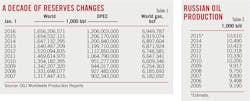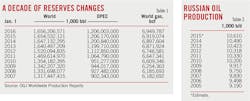Reserves grow modestly as crude oil production climbs
Conglin Xu
Senior Editor-Economics
Tayvis Dunnahoe
Exploration Editor
Michael T. Slocum
Upstream Technology Editor
Laura Bell
Statistics Editor
The world's crude oil and condensate reserves total 1.656 trillion bbl at yearend 2015 compared with 1.654 trillion a year earlier, according to Oil & Gas Journal's annual assessment. Total natural gas reserves are 6.95 quadrillion cu ft, up 30.7 tcf from those reported a year ago.
While US reserves continue to break records, most changes elsewhere are small.
The published reserves figures rely on survey responses and official updates by individual countries, which are not provided every year in many cases. OGJ changes its estimate for a particular country only when it receives evidence that a change is in order.
Despite the slump in oil prices, global oil production is projected to increase 2.6% in 2015, averaging 78 million b/d, led by the US and members of the Organization of Petroleum Exporting Countries.
Reserves changes
On a regional basis, Asia-Pacific oil reserves edged upward to 46.06 billion bbl from 45.89 billion bbl in the previous survey. Of the countries showing marked increases, China's crude oil reserves increased more than 483 million bbl to 25.13 billion bbl, according to the China Statistical Yearbook 2015. China's natural gas reserves are now 174.63 tcf, up from 163.96 tcf last year.
Indian Petroleum & Natural Gas Statistics 2014-15 cited an increase for India's crude reserves to 5.68 billion bbl from 5.67 billion bbl for the previous year. Natural gas reserves increased to 52.57 tcf from 50.39 tcf a year ago.
OGJ decreased its reserves estimates in Western Europe primarily to correct numbers for Germany, for which earlier estimates included probable reserves. Germany's proved crude reserves are 132.48 million bbl, down from 146.88 million bbl a year ago, according to the German oil and gas producer association (WEG).
Starting in 2013, the Netherlands reported its resources according to the Petroleum Resources Management System (PRMS), which distinguishes between remaining reserves and contingent resources. The Netherlands crude reserves are 140.89 million bbl, down from 144.66 million bbl reported previously. Natural gas reserves have also been lowered from 31.7 tcf to 26.87 tcf.
Norway's crude reserves declined to 5.13 billion bbl from 5.49 billion bbl. Natural gas reserves are 67.87 tcf, down from 72.35 tcf a year ago, according to the Norwegian Petroleum Directorate.
UK reserves dipped to 2.75 billion bbl from 2.98 billion bbl, according to the recent estimates from the Oil & Gas Authority. Natural gas reserves are 7.25 tcf, down from 8.5 tcf reported last year.
Estimates of proved oil reserves for countries in the Western Hemisphere total 551.66 billion bbl compared with last year's 548.47 billion bbl. Gas reserves for the hemisphere now stand at 728.89 tcf, up from 700.43 tcf a year earlier.
According to the Argentine Petroleum & Gas Institute, Argentina's reserves estimate for oil increased 1.1%, while its gas reserves are up 5.3%. Peru reported a decrease of 8% in oil reserves to 682.68 million bbl and a decrease of 3% in gas reserves.
In Brazil, crude reserves increased to 16.18 billion bbl from 15.54 billion bbl a year ago, according to the National Petroleum Agency.
OPEC reserves
The most recent estimate shows that proved crude oil reserves of OPEC member countries was largely unchanged from a year ago at 1.206 trillion bbl, according to the organization's 2015 Annual Statistical Bulletin. That's 73% of the world's total.
OPEC reported a 0.1% increase in proved gas reserves to 3.359 quadrillion cu ft, more than 48% of the world's total, according to OPEC. Saudi Arabia accounted for most of the increase: to 299.78 tcf from 293.7 tcf. Angola and Venezuela also added natural gas reserves.
US, Canada, Mexico reserves
The US Energy Information Administration reported that US crude oil and lease condensate proved reserves increased to 39.9 billion bbl in 2014-an increase of 3.4 billion bbl from 2013.
US proved reserves of crude oil and lease condensate have risen for 6 consecutive years and exceeded 39 billion bbl for the first time since 1972. Proved reserves of US dry natural gas increased 9% to 368.7 tcf.
Texas leads state's with 60% of the US crude oil proved reserves increase, about 2.05 billion bbl, mostly from the Permian basin and Eagle Ford shale play. North Dakota had a net gain of 362 million bbl, the second-largest statewide increase. Most of that gain occurred in the Bakken play of the Williston basin.
Pennsylvania added the most natural gas proved reserves in 2014 with 10.4 tcf due mostly to the prolific Marcellus shale play. Texas added 8 tcf, mostly from the Eagle Ford shale and gas associated with oil in the Permian basin. Natural gas from shale formations was 51% of the US total of proved gas reserves in 2014.
EIA forecasts that, due to sustained crude oil and gas prices that have slowed drilling and reduced operating economics, next report for yearend 2015 will reflect a reduction in reserves.
The Canadian Association of Petroleum Producers reported proved oil reserves in Canada at 170.86 billion bbl, down from 172.48 billion bbl in the previous survey.
According to the most recent estimates, conventional crude and condensate reserves in Canada stand at 4.56 billion bbl, and oil sands reserves are 166.32 billion bbl. The country's gas reserves are 70.5 tcf, down from 71.7 tcf a year ago.
Petroleos Mexicanos reported that oil reserves in Mexico decreased about 100 million bbl to 9.7 billion bbl and proved gas reserves fell to 15.3 tcf from 16.5 tcf.
Oil production
Worldwide oil production this year averaged 78.18 million b/d, up from 76.2 million b/d in 2014, according to OGJ estimates. All regions except Africa experienced output growth.
With a policy to defend market share rather than price, OPEC crude production this year is estimated at an average of 31.22 million b/d compared with 30.26 million b/d last year. Saudi Arabia and Iraq, the group's largest producers, have ramped up production from 2014 levels.
Libya's production is estimated to have fallen above 13% this year to 407,000 b/d due to long-running political instability. Nigeria's production averaged 1.9 million b/d in 2014 and is expected to dip this year.
OGJ estimates that non-OPEC production in 2015 will average 46.96 million b/d, up 2.2% from a year earlier.
Combined output in the Western Hemisphere will increase 3% this year to 22.48 million b/d, led by strong increases in the US, Canada, and Brazil.
US production will lead regional and global supply gains this year, increasing 7.7% to 9.38 million b/d. However, US onshore oil production is declining due to lower oil prices and continued declines in US drilling.
Output from Canada is projected to rise 1.1% to 3.65 million b/d this year. Brazil's production, meanwhile, is projected to reach 2.44 million b/d, up 8.9% from a year ago.
Despite myriad challenges to its energy industry, Russia is setting production records this year as oil from new projects more than offsets declines at aging fields. OGJ estimates that oil production in Russia will be up 1.1% from a year ago, averaging 10.61 million b/d.
Output in Western Europe increased 4.2% from a year earlier, as Norway and the UK reported higher oil production.
In the Asia-Pacific region, the collective oil output this year will grow 1.9% to 7.6 million b/d due to higher output in China and Malaysia.

